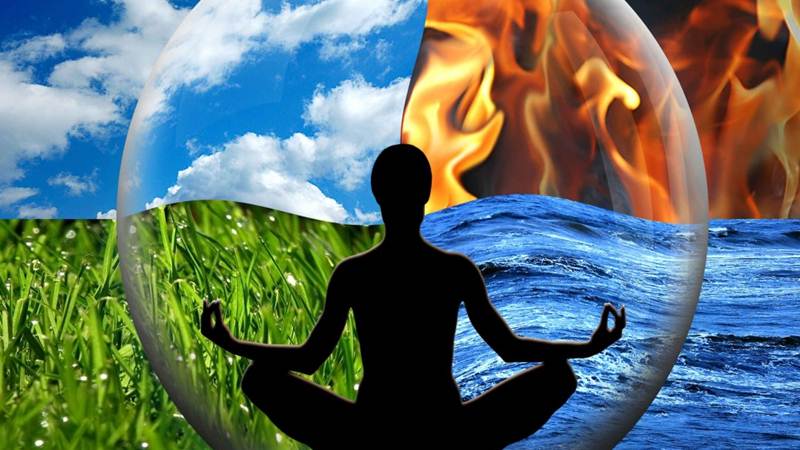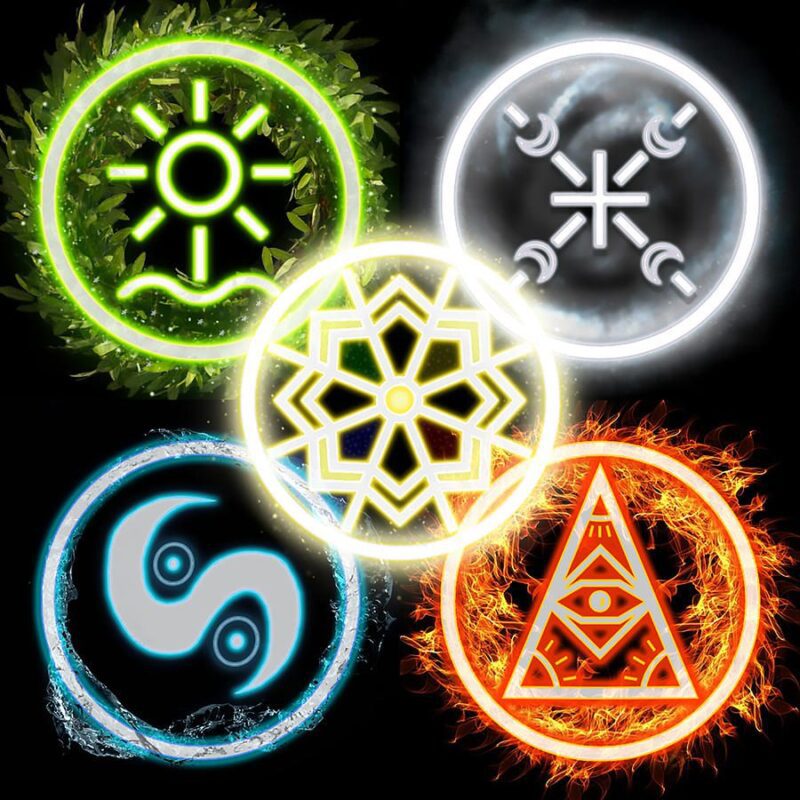
They are the fundamental building block of nature. The Five element of nature combines, forming the life force. According to ‘Panchabhootha Siddhanta’, the physical world is considered to be derived from these element of nature. Basic elements get absorbed into each other forming gross elements called ‘Panchamahabhuta’.
They intermix resulting in the formation of various substances found in the universe. This manner of specific combining is called ‘Pancha Panchika’. Panchamahabhuta is hence considered responsible for the creation of this entire material world.
Just like any other creature, humans are also composed of these elements. In our body bones and teeth is a symbolic representation of the earth. Blood and lymph are derivatives of water, fire represents metabolism, air represented by oxygen and space between matter is ether.

According to Ayurveda and Yoga diseases are caused by the imbalance of elements of nature in our body. ‘Hastha Mudra’ in yoga considers each finger as associated with different elements and is an application of ‘Panchamahabhuta Siddhanta. Certain Mudras are used to regain the elemental balance of the body. This concept is often used in the medical field, like in Naturopathy.
The five-element of nature mentioned in the ‘Panchamahabhuta theory’ are Earth, Water, Air, Fire and Space.
Earth

Earth or Prithvi is the first element of nature, it can be touched and smelled. But the special sense often associated with the earth is the smell. The nose is the sense organ corresponding to the earth in our body.
Earth is clear, dense, heavy, large and bulky. It is often classified as the rough, hard, slow, firm and inactive element. It’s neither hot nor cold.
Earth exists in two forms. First one is eternal and is called ‘Nitya’. This is the form of Parmanu or atom. This is eternal as even after the creature is dead, it takes its eternal form after disintegration. ‘Anitya’ is the second form that is perishable.
In the human body Nails, Bones, Tendons, Teeth, muscles, skin, stool, hair and spinal cord are associated with earth. These are all perishable forms.
Water

The second element of nature is water or Jal. It can be touched and tasted. A special sense related to it is taste. So the tongue is the sense organ for this element of nature. Its movement is always downward.
It is cold, slimy, dense and always moves in the direction of gravity. Water has fluidity and is heavy, soft and inactive. All fluids in our body, fatty tissue, kapha, urine, sweat, pitta and semen are all derivatives of ‘Jala’.
Just like the first element, Jala also has perishable and non-perishable forms. The perishable form of Karya in the form of rivers, ponds or seas. These are perishable as the water evaporates and condenses, forming clouds, and then precipitation brings it back to earth. So on an atomic level, it’s eternal.
Air

It is only possible to feel the air. So the sense organ corresponding to it is skin and the sensation is touch. It is also called ‘Vayu’. The movement of Vayu is centrifugal in nature. It is often associated with active movement.
Some of the properties that distinguish it from another element of nature are that it is light, rough, clear and minute. It’s neither hot nor cold.re
Air is responsible for all body activities, pulsation, all gaseous movement like inspiration and expiration of air and all movements in the body. Temporary sensations of air like breeze or storms are the perishable forms of Vayu, but it mainly exists in its atomic form that is eternally present around us.
According to Vedas, there are 49 different types of Maruts. Udvaha and Pravaha are two of the Maruts on this list.
Fire

It is the fourth element of nature. It is called Agni.
Fire is a very important element mentioned in Hindu mythological texts as it is one of the ‘Asta-Dik-Palakas’ or the eight guardians of the universe. It is related to vision so the sense organ associated with it in the eye.
Fire is often described as light, rough, sharp, clear, minute, active and dry luminous. It spreads very fast and it is the only element of nature that moves upward. It is hot in nature.
This element of nature can be felt in the body as Body heat. Some texts also mention pitta and lustre as a result of the fire. Fire also exists both in transient and eternal forms.
Space
.jpg)
Space is the fifth element of nature, is called Akash or Ether. The special organ for this element is the ear. So the special sensation is sound. It is the only element with no particular direction of movement, motion is rather absent in the case of this element.
Space is light, smooth, soft, light, inactive, clear and minute. It is often associated with separation and differentiation. It is neither hot nor cold.
Space is involved in all body activities as it is represented by the space between matter in the human body. All body passages and cavities come under this. Unlike earth, water, air and fire, it does not have two forms. Space exists only in the eternal form.
Applications
The ‘Panchabhuta Siddhanta or the ‘Panchamahabhuta theory’ has applications in multiple fields. The Tridosha theory is a biological application of the concept of five elements. This has wide application in medicine and yogic practices.
According to the Tridosha theory, three dosas constitute the human body. The three doshas are Vata, Pitta and Kapha. Vata is a predominance of the Mahabhutas Vayu and akasa, pitta is the predominance of Agni and Kapha is the predominance of Jala and Prithvi.
If the equilibrium of the three is lost then physical problems will start occurring as diseases. Bringing back this balance is essential for regaining one’s health. Ayurvedic medical practices aim at bringing back the equilibrium. So understanding the theory of five elements is very important in this field of science.
Practices in yoga-like Bhuta Shudhi fix the reasons for these elemental imbalances at its roots and cleanses the elements in our body.
Vastu Shastra is another field whose roots are deeply based on Pancha Bhootha Siddhanta. Certain alignment of the house or construction with nature is believed to enhance life force energy inside the building. According to Vastu Shastra, each direction is guarded by a heavenly force and our lives are very much influenced by these components of life.

